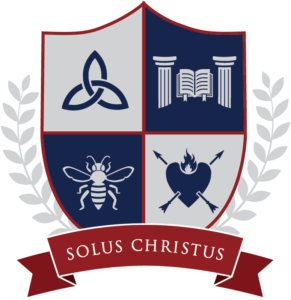
One of the most notable paintings of the Reformation is the Weimar Altarpiece. It was begun in 1552 by Lucas Cranach the Elder, who died before the work was completed, and finished in 1555 by his son, Lucas Cranach the Younger. The painting is a triptych (3 hinged panels) with the center panel depicting the crucifixion of Christ. Standing roughly twelve feet tall and ten feet wide, the painting includes figures in the foreground that are about as large as the men they portray. Besides being an impressive undertaking, the work is also beautifully detailed, with numerous Biblical scenes depicted in the background, midground, and foreground, all with rich theological connections.
Of chief importance in the painting is the crucifixion of Christ depicted in the center of the painting. The viewer also notes a second Christ standing to the left in the foreground as the risen Lord and crushing death and Satan under His feet. By the risen Jesus is the empty tomb with sunlight just beginning to glow from behind it. One would quickly remember the words of Genesis 3:15—“he shall bruise your head, and you shall bruise his heel”—while looking at this vivid depiction. All the other details in the painting serve to elevate Christ and His work of salvation.
Among one of the scenes depicted in the background, an angel in the sky sings the news of Christ’s birth to the shepherds in the field watching their sheep. This ties nicely to the lamb depicted at the foot of the cross in the foreground. Moses can be seen erecting the bronze serpent in the wilderness, a serpent wrapped around the same sort of cross upon which Jesus hangs. Moses a second time appears in the background looking at the Ten Commandments and pointing to Christ. This mirrors the image of John the Baptist in the foreground, who is also gesturing up towards Jesus with his hand in the same position. Death and Satan are seen tormenting a poor sinner who is running headlong into the flames of hell, though looming larger in the foreground is their own demise under the feet of Christ. The repetition of related themes throughout the painting artfully supports Christ as the central figure to whom all history had been pointing.
In the foreground on the right side, beside the figure of John the Baptist pointing to the Lamb of God who takes away the sin of the world, two other men stand. One is Martin Luther, who is holding an open book. The German words painted into the book are several key Scripture passages that relate to the scene. The verses include 1 John 1:7, “The blood of Jesus…cleanses us from all sin,” then Hebrews 4:16, “Let us then with confidence draw near to the throne of grace, that we may receive mercy and find grace to help in time of need,” and finally John 3:14-15 “And as Moses lifted up the serpent in the wilderness, so must the Son of Man be lifted up, that whoever believes in him may have eternal life.” These verses are well-paired with the themes of the painting. The other man standing by Luther is the painter himself, Lucas Cranach the Elder. He included himself in a way that again highlights the work of Christ: above his head is a stream of Christ blood, a painted confession that Christ shed His blood to save him.
In Christ,
Miss Engwall

